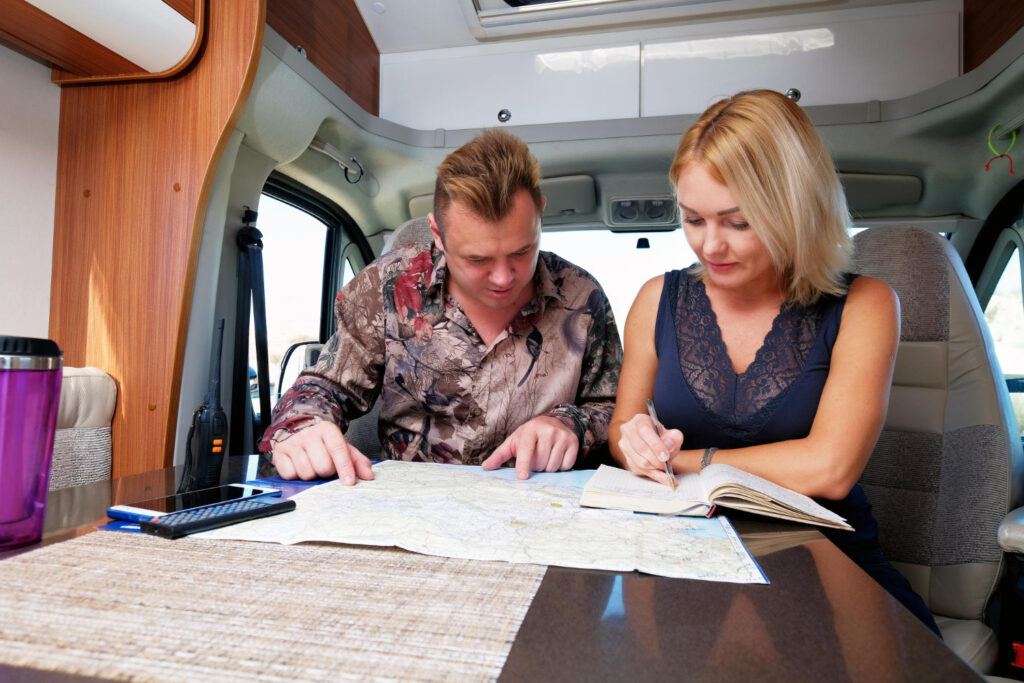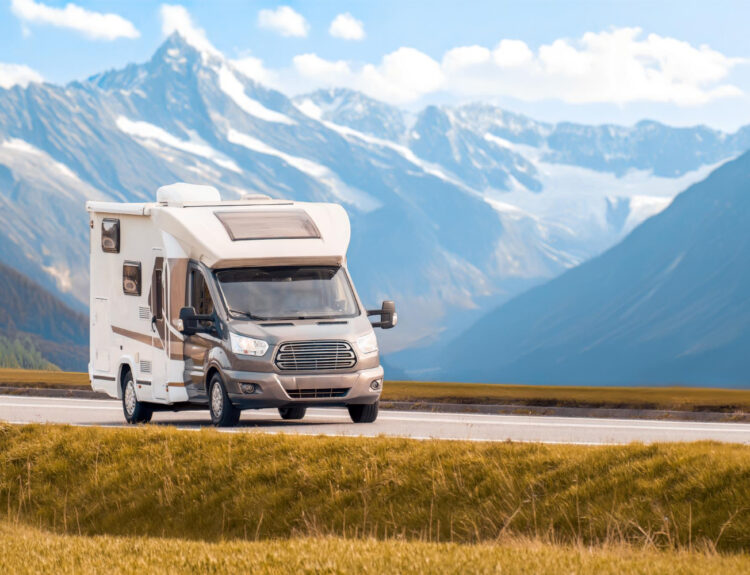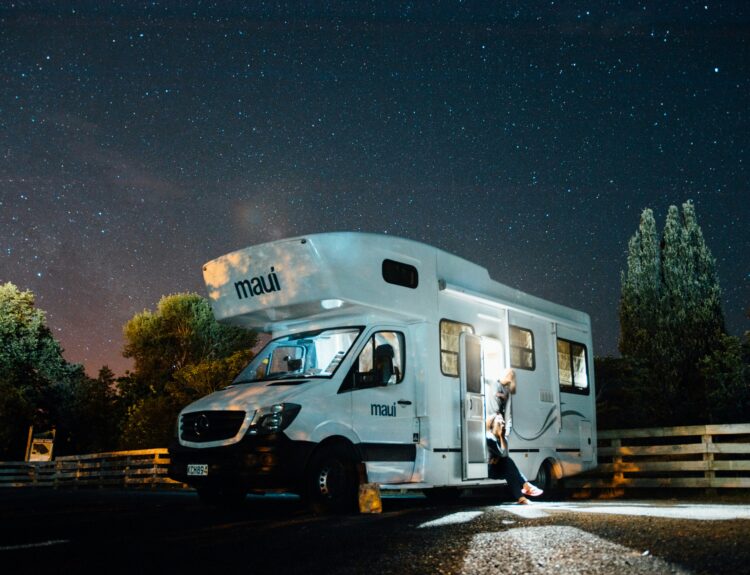The allure of full-time RVing is hard to resist. Imagine waking up to the sound of birds in a national forest, sipping coffee in the desert, or working remotely with ocean views from your window. But behind those picture-perfect moments is a lifestyle that demands smart planning, the right gear, and the mental flexibility to adapt on the fly.
Whether you’re dreaming of life on the road or already living it, understanding the essentials will help you build a sustainable and enjoyable full-time RV journey. In this guide, we cover the most important full-time RVing resources and tips—from budgeting and campsite selection to internet access, maintenance, and financial planning.
Key Takeaways:
- Full-time RVing requires careful budgeting, planning, and choosing the right RV for your lifestyle.
- Finding affordable and legal campsites, boondocking locations, and RV parks is essential.
- Reliable internet access and connectivity are crucial for remote work and staying in touch.
- Proper RV maintenance and emergency preparedness prevent costly breakdowns on the road.
- Utilizing membership programs and financial strategies helps save money while traveling full-time.
Planning & Budgeting for Full Time RV living
Going full time in an RV starts long before you put the keys in the ignition. It begins with careful planning that ensures your new lifestyle is both sustainable and aligned with your personal goals. Many aspiring RVers underestimate how much pre-trip prep they need. Understanding your expenses, lifestyle preferences, and long-term goals is critical.
First, assess your finances. Determine what you can afford monthly, and don’t forget to include fuel, maintenance, insurance, groceries, internet access, entertainment, and campground fees. Then think about how often you want to move. Constant travel can rack up fuel and maintenance costs quickly, while longer stays tend to reduce expenses. Planning for emergencies—both financial and mechanical—is also a key part of budgeting.
Choosing the right RV is another crucial step. This decision should reflect your lifestyle. Are you someone who wants a spacious living room and full kitchen? Or do you prefer a more nimble, minimalist approach that allows access to remote boondocking locations? Think long-term comfort, not just aesthetics. Once you’ve made your plan, built your budget, and selected your RV, you’ll be in a much stronger position to hit the road with confidence.

Choosing the Right RV for Full-Time Travel
Selecting the right RV is one of the most important decisions for any full-time traveler. The type of RV you choose affects how you travel, where you can stay, how comfortable your experience is, and what kind of maintenance you’ll be responsible for.
- Motorhomes—both Class A (large, bus-like vehicles with spacious interiors and more luxury features) and Class C (typically built on a van or truck chassis and have a distinctive over-cab sleeping area, offering a more compact and budget-friendly option)—offer the convenience of an all-in-one vehicle, with no need to tow. They’re ideal for those who want simplicity when setting up camp and appreciate having their living space integrated with their driving space. However, a class a motorhome comes with higher fuel costs and more complex repairs.
- A travel trailer and fifth wheels, by contrast, offer more interior space and the flexibility of detaching your tow vehicle. This is ideal for longer stays and for those who want to explore towns or attractions without packing up camp.
- For minimalist travelers or those interested in stealth camping, camper vans and truck campers offer simplicity and mobility. They’re great for solo travelers or couples who prioritize flexibility and access to off-grid locations. However, storage space and living amenities are limited, so comfort may be compromised on long trips.
How Much Does Full-Time RVing Cost?
Costs can vary widely based on your travel style. If you prefer staying in luxury RV resorts, eating out frequently, and covering long distances, your expenses will be higher. If you boondock on public land, cook your own meals, and take advantage of discount memberships, you can significantly reduce costs.
A realistic monthly budget often ranges between $2,000 to $4,000 for a full time rver. This includes fuel, campground fees, groceries, internet, insurance, maintenance, and entertainment. Fuel will likely be your most variable cost, especially if you travel long distances frequently. Campground fees can range from free boondocking sites to $100-per-night resorts, so your preferences make a big impact.
Many full time RVrving travelers find their overall cost of living drops compared to traditional life in a house or apartment. You may not have a mortgage or rent payment, and if you’re boondocking and cooking your meals, you’ll save significantly. However, unplanned repairs or medical expenses can catch you off guard, so it’s important to build a buffer into your budget.
Finding the Best Campsites & Boondocking Locations
Where you park your RV determines much of your daily experience. The right site can offer peace, beauty, and convenience—while the wrong one can leave you frustrated or uncomfortable. As a full time RVer, you’ll need to understand how to balance comfort, cost, and accessibility in your campsite choices.
Some campers RVrving full time prefer the predictability of RV parks, where hookups, laundry, showers, and Wi-Fi are usually available. Others chase solitude and adventure, camping on public lands or in remote locations. Choosing the right mix depends on your travel goals, RV capabilities, and tolerance for off-grid living.
Learning how to find safe, legal, and enjoyable places to stay is one of the most important full-time RVing resources & tips you can master. Fortunately, many tools and apps exist to make that process easier.
RV Parks vs. Boondocking – What’s Best for Full-Timers?
RV parks offer a comfortable and social environment. They’re especially convenient for those who need regular access to electricity, water, dump stations, or laundry. They also provide a sense of RV community, with organized events and neighboring RVers nearby. However, staying at these parks full-time can be expensive and may limit your access to nature.
Boondocking, or camping without hookups, provides a low-cost and often scenic alternative. Common locations include Bureau of Land Management (BLM) lands, national forests, and dispersed camping areas. Boondocking allows you to immerse yourself in nature, but it requires self-sufficiency. You’ll need solar power or a generator, a water storage plan, and good waste management.
Many campers who RV full time choose to alternate between RV parks and boondocking to balance comfort and cost. This hybrid strategy gives you the flexibility to enjoy the best of both worlds while staying within your budget.
How to Find Great Camping Spots
Several apps and websites can help you locate great places to camp, no matter your preferences. RoverPass is a great tool for booking stays at private RV parks and campgrounds across the country. With its user-friendly booking system and wide database, it simplifies the process of finding and reserving a spot that meets your needs.
Campendium and FreeCampsites.net are popular among campers for their RV community-driven reviews and filters. They help you evaluate cost, cell service, road conditions, and amenities. For boondocking and remote adventures, apps like iOverlander and The Dyrt offer detailed maps and GPS coordinates, often with pictures and safety information.
For a unique experience, consider joining Harvest Hosts. With annual camping memberships, you can stay overnight at farms, wineries, breweries, and other unique venues for free—though purchasing something from your host is encouraged.

Staying Connected – Internet and Mobile Resources for RVers
Internet connectivity is a lifeline for many full-time RVers, especially remote workers and families with school-aged children. Having access to reliable internet allows you to work, stay in touch with family, stream entertainment, and manage your travels.
There’s no one-size-fits-all internet solution on the road. RVers often use a mix of services to stay connected as they move between areas with different levels of coverage.
Best Mobile Internet Solutions for RVers
Starlink has become a game-changer in the mobile internet resource center for RVers. This satellite internet service offers fast and stable connections even in remote locations—provided you have a clear view of the sky. For full-timers traveling in rural areas, Starlink is often the most consistent option.
Mobile hotspots are another popular choice. Devices from Verizon, AT&T, or T-Mobile let you use cellular data to power your laptop or smart TV. Coverage depends on your carrier and location, so many RVers carry plans from multiple providers to ensure coverage wherever they go.
A cell signal booster, such as the WeBoost Drive Reach, can strengthen weak signals and improve your overall connectivity. Campground Wi-Fi is often unreliable, so it’s best used as a backup. Investing in a flexible internet setup is one of the smartest things you can do as a full-time RVer.
RV Maintenance & Emergency Preparedness
An RV is a rolling home, and like any home or vehicle, it needs consistent care for the road trip. Regular maintenance keeps you safe, saves money, and helps prevent unexpected breakdowns that can derail your plans. Emergency preparedness also ensures you’re ready when the unexpected happens.
Essential RV Maintenance Tasks for Long-Term Travel
Start with a maintenance checklist tailored to your rig. At a minimum, inspect your tires regularly for wear, pressure, and punctures. Tire blowouts are one of the most common RV issues—and one of the most dangerous.
Other routine checks include inspecting roof seals for leaks, testing your RV’s batteries and electrical system, servicing the generator, and maintaining your water and propane systems. Neglecting these tasks can lead to costly repairs and inconvenient delays.
Create a maintenance schedule, track your service history, and always carry a basic toolkit. The more you know about your rig, the easier it is to prevent problems or troubleshoot them on the go.
Handling Breakdowns & Roadside Assistance
Even the best-maintained RVs can break down. That’s why having a reliable roadside assistance plan is essential. Services like Good Sam, Coach-Net, and AAA RV Plus offer towing, tire repair, fuel delivery, and lockout services. Compare plans carefully to make sure they cover your RV type and travel regions.
Keep emergency gear on hand, including jumper cables, a jack, flashlights, and reflective triangles. Having a clear plan—and knowing who to call—will turn a potential crisis into a manageable inconvenience.

Managing Finances and Making Money on the Road
One of the most frequently asked questions about RV life is, “How do you afford it?” The answer lies in smart financial planning and creating income streams that are compatible with a mobile lifestyle.
How to Fund Your Full-Time RV Lifestyle
Remote work is the most common way full-timers earn income. Freelancing in areas like writing, graphic design, software development, or customer support gives you the flexibility to travel while working. Many RVers also run online businesses or work as digital content creators.
Others take seasonal jobs in national parks, campgrounds, theme parks, or retail stores. These short-term gigs often provide free or discounted campsites, which helps offset expenses.
Regardless of your income source, managing your budget is key. Use financial tools to track spending, set savings goals, and prepare for slow months. With the right strategy, full-time RVing can be financially sustainable—and even help you reach long-term financial goals.
Your Journey Starts with the Right Tools
Full-time RVing is more than just a lifestyle—it’s a commitment to freedom, flexibility, and continuous learning. With the right resources, realistic planning, and a spirit of adventure, life on the road can be both fulfilling and financially sustainable. Whether you’re chasing sunrises across the desert or working from the mountains, being prepared is what transforms the dream into a lasting reality.
And when it comes to finding your next stop, tools like RoverPass make it easier to keep your travels smooth and stress-free. With thousands of bookable campgrounds and RV parks at your fingertips, you can spend less time searching and more time exploring. Safe travels—and we’ll see you out there.
Frequently Asked Questions
How do full-time RVers establish a legal domicile and receive mail on the road?
To stay compliant with taxes, insurance, and vehicle registration, full-time RVers need a legal domicile—a state where they maintain a legal address. Texas, Florida, and South Dakota are popular choices because they are income-tax-free and have RV-friendly laws. Mail-forwarding services like Escapees and Traveling Mailbox provide permanent addresses and mail scanning so you can access your mail digitally from anywhere.
What are the best health insurance options for full-time RVers?
Health coverage varies depending on your home state and travel patterns. ACA-compliant plans can work if you stay within certain networks. Many RVers choose nationwide PPO plans or health-sharing ministries that offer coverage across state lines (like a RV insurance). If you travel internationally, look into travel medical insurance as a supplement.
How do full-time RVers handle vehicle registration and driver’s license renewals while traveling?
Most RVers handle these tasks through their domicile state. Many states offer online renewals and mail-in services, making it possible to stay compliant without returning in person. Using a mail-forwarding service helps ensure you receive renewal notices and important documents on time.
What are the biggest challenges of full-time RVing, and how do people overcome them?
Common challenges include mechanical breakdowns, loneliness, spotty internet, and financial uncertainty. RVers overcome these by staying connected with community groups, investing in good equipment, maintaining a realistic budget, and planning routes with connectivity in mind. Flexibility and problem-solving skills are essential for long-term success.
How do families with children handle homeschooling and education while living in an RV?
Many full time RVing families homeschool their children using online curriculums or hybrid education models. Programs like Time4Learning, Khan Academy, and Outschool offer flexibility and accreditation. Socialization happens through meetups, events, and connections made at campgrounds. Education on the road can be enriching and hands-on, with national parks and historical sites serving as real-life classrooms.






